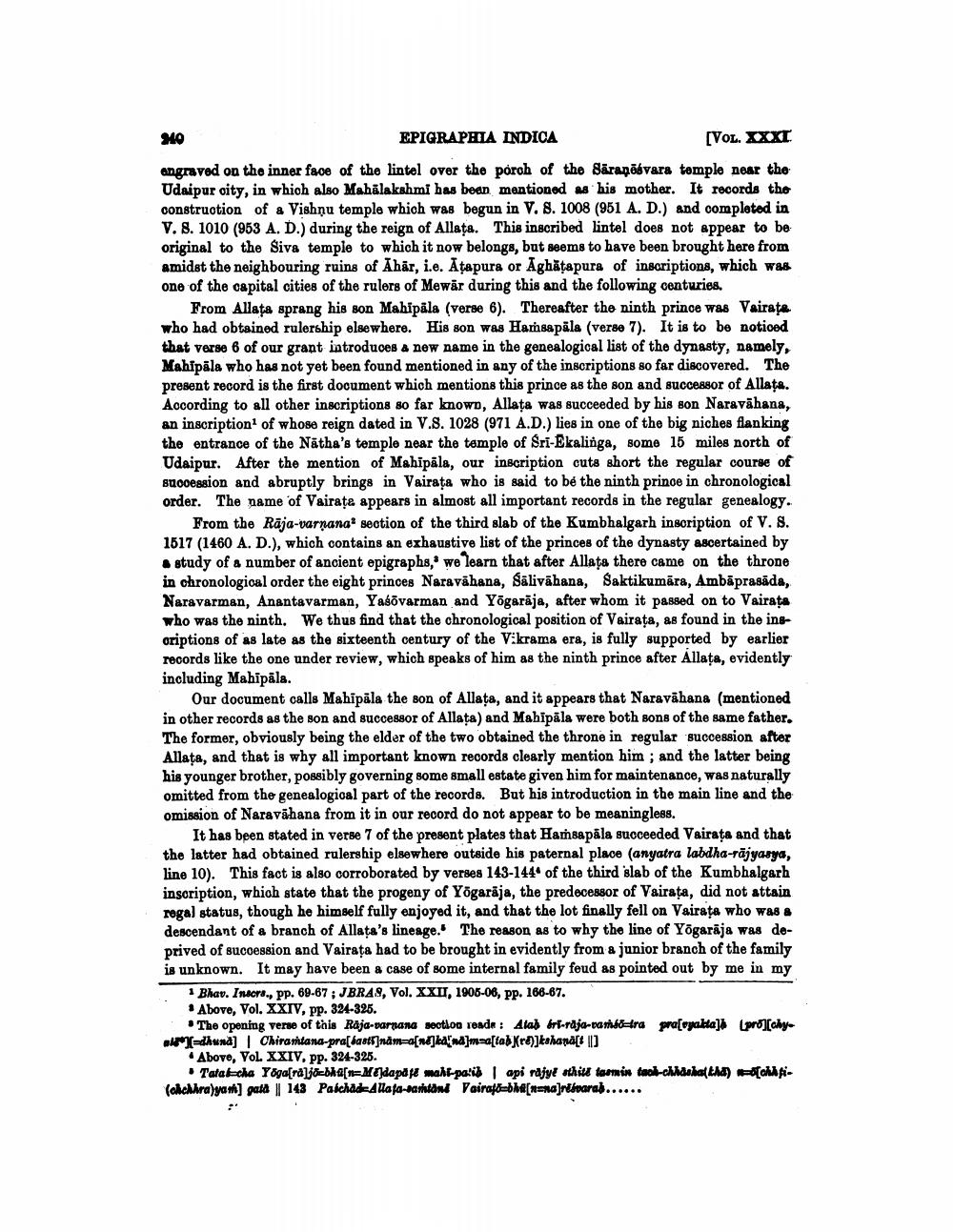________________
Mo
EPIGRAPHIA INDICA
[VOL. XXXI
engraved on the inner face of the lintel over the porch of the Särapõbvara temple near the Udaipur city, in which also Mahalakshmi has been mentioned as his mother. It records the construction of a Vishnu temple which was begun in V. 8. 1008 (951 A. D.) and completed in V. 8. 1010 (953 A. D.) during the reign of Allata. This inscribed lintel does not appear to be original to the Siva temple to which it now belongs, but seems to have been brought here from amidst the neighbouring ruins of Ahār, i.e. Ātapura or Aghātapura of inscriptions, which was one of the capital cities of the rulers of Mewar during this and the following centuries.
From Allata sprang his son Mahipäla (verse 6). Thereafter the ninth prince was Vairata who had obtained rulership elsewhere. His son was Hamsapāla (verso 7). It is to be noticed that verse 6 of our grant introduces a new name in the genealogical list of the dynasty, namely, Mahipala who has not yet been found mentioned in any of the inscriptions so far discovered. The present record is the first document which mentions this prince as the son and successor of Allata. According to all other inscriptions so far known, Allața was succeeded by his son Naravāhana, an inscription of whose reign dated in V.8. 1028 (971 A.D.) lies in one of the big niches flanking the entrance of the Nätha's temple near the temple of Sri-Ekalinga, some 15 miles north of Udaipur. After the mention of Mahipala, our inscription cuts short the regular course of Bu00ession and abruptly brings in Vairata who is said to be the ninth prinoe in chronological order. The name of Vairate appears in almost all important records in the regular genealogy.
From the Rāja-varnana section of the third slab of the Kumbhalgarh inscription of V. 8. 1517 (1460 A. D.), which contains an exhaustive list of the princes of the dynasty ascertained by • study of a number of ancient epigraphs, we learn that after Allata there came on the throne in chronological order the eight princes Naravāhana, Sālivāhana, Saktikumāra, Ambāprasāda, Naravarman, Anantavarman, Yasovarman and Yögaräja, after whom it passed on to Vairata who was the ninth. We thus find that the chronological position of Vairaţa, as found in the inscriptions of as late as the sixteenth century of the Vikrama era, is fully supported by earlier records like the one under review, which speaks of him as the ninth prince after Allata, evidently including Mahīpāla.
Our document calls Mahipala the son of Allata, and it appears that Naravāhana (mentioned in other records as the son and successor of Allata) and Mahipala were both sons of the same father. The former, obviously being the elder of the two obtained the throne in regular succession after Allata, and that is why all important known records clearly mention him ; and the latter being his younger brother, possibly governing some small estate given him for maintenance, was naturally omitted from the genealogical part of the records. But his introduction in the main line and the omission of Naravāhana from it in our record do not appear to be meaningless.
It has been stated in verse 7 of the present plates that Hamsapāla succeeded Vairata and that the latter had obtained rulership elsewhere outside his paternal place (anyatra labdha-rājyasya, line 10). This fact is also corroborated by verses 143-1446 of the third slab of the Kumbhalgarh inscription, which state that the progeny of Yögarāja, the predecessor of Vairata, did not attain regal status, though he himself fully enjoyed it, and that the lot finally fell on Vairaţa who was & descendant of a branch of Allata's lineage. The reason as to why the line of Yögarāja was deprived of succession and Vairata had to be brought in evidently from a junior branch of the family is unknown. It may have been a case of some internal family feud as pointed out by me in my
1 Bhav. Inaors., pp. 69-67; JBRAS, Vol. XXII, 1906-06, pp. 166-67. . Above, Vol. XXIV, pp. 324-325. • The opening verse of this Raja-varnana section reade: Alas bri-raja-name-fra prasoyadla) prd][chy "][-dhund) | Chirantana-pra[basti]nama[nl] land]m-a[tabrd)]kahana[t )
Above, VOL. XXIV, pp. 324-325.
Tatat-cha Yoga[raljo-bh[n=MÉdapat mahi-pa!ib api rajyt sthit toomin taob-chhasha tha) [chfi(chchhrayyari) gala || 143 Paschade Allata-samland Vairafd-bh[n=najribaral......




